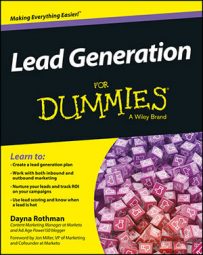The first step to creating your search engine optimization (SEO) strategy is to choose your keywords. Ask yourself what you want to rank for. This can be answered after asking yourself and your team a series of simple questions:
What does my company do?
What is the key search term(s) people use when they want to learn more about my business?
What are my different product/service lines?
What needs do my product/service fill?
What are the features of my product/service lines?
What keywords do my competitors rank for?
Where am I ranking now for these keywords?
What is the traffic opportunity for each keyword?
Building a better keyword list
After you have the answers to the preceding questions, you can start thinking about what keywords make sense and then create a strategy to optimize for your chosen terms. Note that you won't have a fully baked and executed strategy overnight, so plan on instituting a step-by-step approach to optimization. Start with your top keywords, and then go from there.
If you are having trouble coming up with keywords, leverage Google Keyword Planner. You must have an AdWords account to access the tool (which you should have anyway), and you can search for keyword ideas and get estimates for search volume. It's a terrific place to start. Simply go to the Tools and Analysis navigation in your Google AdWords account and click on Keyword Planner in the drop-down menu.
Initially, a great way to keep track of your keywords and priorities is to create a spreadsheet that lists each keyword, keyword phrase, its priority, and the page URL you want your keyword to link to, which should be the page that you want to rank for. To determine keyword priority, think about the keywords that map closest to your core competencies as a business. For instance, if you own a hair salon, your top priority keywords might be salon, hair, hair salon, beauty, hair styling, and so on. And then, you might choose keywords like waxing, coloring, makeup application, and so on, for the next level of priority.
Optimizing for keywords
There are many ways to optimize for keywords throughout your site. After you choose and rank your top keywords and determine which page you want to rank for each term, you need to make sure each page is optimized — meaning you are making it easy for a search engine to know exactly what your page is talking about.
Of course, the first step to keyword optimization is through on-page SEO and good content. However, there are a couple of additional techniques you can use to make sure each page is optimized correctly for each keyword:
Headline: Your headline on a web page should always match your keyword page titles. If a visitor clicks your page title in the search engine results, she expects a certain outcome. It is critical for user experience and keyword consistency to make sure your headline (H1, in HTML-speak) delivers the right message. Note that your H1 doesn't have to match your title exactly, but it should be similar enough that your visitor isn't confused. For instance, if someone searches for marketing automation on Google, he expects to go to a page that has a headline about marketing automation, such as "Marketing Automation Success Center." If he goes to a page that says "lead nurturing software," he might be a tad confused.
Images: Using images on your page can help your SEO rankings. Also note that your image can come up on Google image search, so you want to make sure all of your images are optimized. Moz, a popular SEO blog and consultancy, suggests that your image have a title, a filename that contains keywords (as opposed to unrecognizable abbreviations), and attributes (alternative text that is rendered when an image can't be seen, for instance, if someone views your page on a phone. The alt text tells a viewer what he should be looking at) as a good SEO practice. Each of these elements can be added via your website content management system (CMS).

